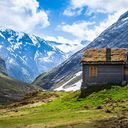Traversing The Alps With A Mountain Bike
For many mountain bikers, crossing the Alps is a bucket list item. For those fortunate enough to have done this already, their eyes light up when they share their experience. But it's not as common to hear about the tricky preparations. Which route is the best for me? How should I train? And what should I bring? We've collected the most important information here so you can focus on the adventure. In the end, it doesn't matter which route you pick because all bikers who have traversed the Alps have one thing in common: they would do it again.
Find Your Traversing Route
Choose from our ready-to-go Collections with handpicked Tours and lots of handy information, created by passionate people like you.
Filter by
Mountain Biking Collection by 
Mountain Biking Collection by 
Mountain Biking Collection by 
Mountain Biking Collection by 
Mountain Biking Collection by 
Mountain Biking Collection by 
Mountain Biking Collection by 
Mountain Biking Collection by 
Mountain Biking Collection by 
Mountain Biking Collection by 
Mountain Biking Collection by 
Mountain Biking Collection by 
Mountain Biking Collection by 
Mountain Biking Collection by 
Mountain Biking Collection by 
Mountain Biking Collection by 
Mountain Biking Collection by 
Mountain Biking Collection by 
Mountain Biking Collection by 
Mountain Biking Collection by 
Mountain Biking Collection by 
Mountain Biking Collection by 
Mountain Biking Collection by 
The right season
The best time for traversing the Alps depends on where your route is. In the mountains, you can easily build your routine around the opening times of the Alpine huts. Depending on the altitude, these are often only open for a few months a year due to the snow. Naturally, it’s always a little cooler at the beginning and end of the season, and while this might be a reason not to go for some, the reduced crowds make it a dream for others. In this regard, it depends on how important solitude and warm temperatures are to you. If your transalp route is situated at a lower altitude or in a warmer climate, the season is automatically extended. As ever, for a good idea on the best times to go, check with your accommodation.
How To Prepare Your Body
The training you must do to prepare for your adventure is directly related to the difficulty of the route and your current physical level. But one thing is for sure: you will be sitting in your seat for the majority of your day, so accustom your body to that! In case you don't have mountains on which to practice in your area, choose the highest point and go up and down ten times in a row. Then repeat. Ideally, you should start training at least two months before your trip. Endurance does not come overnight.
If you prefer to have an exact training plan, check out this.
Packing List
During the ride:
Helmet, cycling shorts, jersey, rain jacket, socks, cycling shoes, buff
Backpack (25-30 l):
Spare Outfit
Spare jersey, spare cycling shorts, 2 underpants, 2 pairs of socks
During The Day
Water bladder, sunscreen, first aid kit, headlamp, bike lock, energy bars and gels, cell phone, power bank, cash, credit card, passport
At The Hut
Sleeping bag liner, sandals/slippers, comfy pants, fleece, T-shirt, toothbrush and paste, charger for your devices
Tools & Spare Parts
Multi tool, pump, 2 spare tubes, patch kit, duct tape & zip ties, brake pads, chain lube, spare derailleur hanger, spare spokes, 2 shift/brake cables
Safety In The Mountains
Weather
Just like a hearty breakfast, checking the weather forecast is an important part of your daily mountain morning routine. At high altitudes, you may experience heat, rain, high winds and even snow — all in the same day. When packing, check the weather and take equipment for every possible outcome.
Dangers
Rough terrain, narrow and steep paths, falling rocks – all are risks when traversing the mountains and along the coast. Thorough preparation, suitable equipment and an honest evaluation of your own skills are key to staying safe. If you don’t have any experience in certain environments, it's best to bring someone who does.
Respect
Whether you are on a popular trail or off the beaten path, make sure to show respect toward other people and the environment. Beware of other people around – below steep slopes there are often other trails, so don't kick down any rocks. Always leave a place as you found it and show respect for your companions, people you meet and the environment.
Emergency Numbers
Research and keeo the phone number of the local mountain rescue on hand. Make sure you always have some battery left on your mobile device and be cognisant of where you are at all times so you can accurately communicate your location in case of an emergency.
- Call 999 and ask to be put through to mountain rescue in case of an emergency. Mountain rescue Germany: 112
- Mountain rescue Austria: 140
- Mountain rescue Italy: 118









